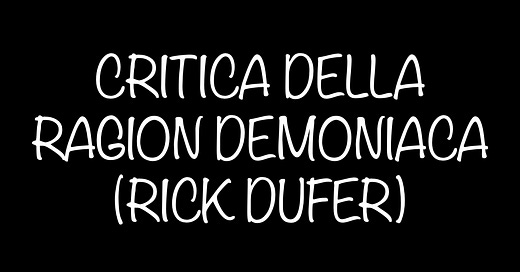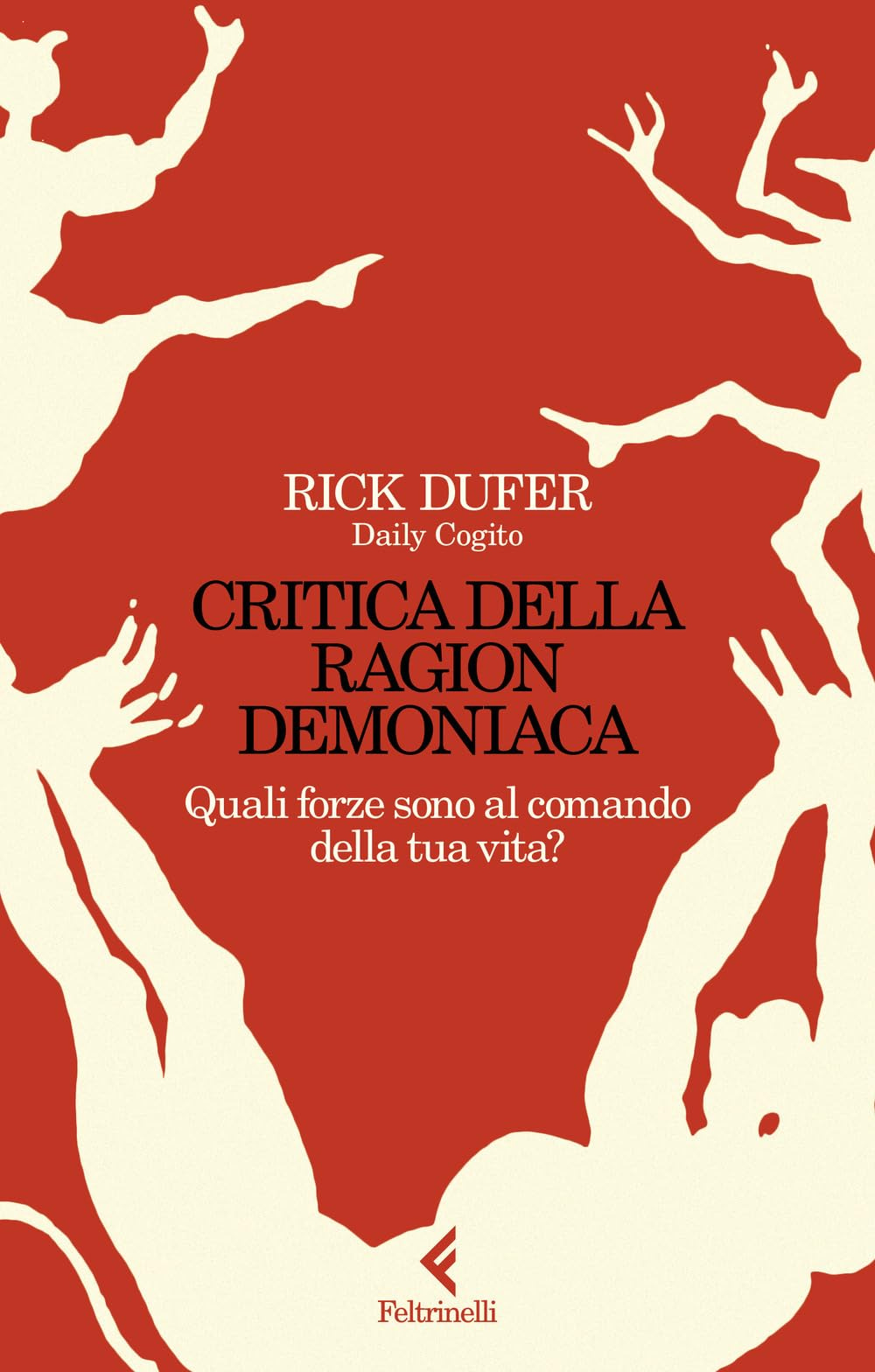Nuts and Bolts Review: Critica della Ragion Demoniaca, Riccardo Dal Ferro
Critica della Ragion Demoniaca: How Distractions and Hyper-Dependencies Threaten Our Consciousness (and How We Can Reclaim It)
⏱️ Reading Time ≈ 15 min
The Book
“Critica della Ragion Demoniaca” is a philosophical essay by Riccardo Dal Ferro (aka Rick DuFer), a contemporary thinker and public intellectual, that delves into the invisible forces shaping our existence. Published in 2024, the book speaks to a conscious and inquisitive audience—those eager to understand the psychological, cultural, and technological mechanisms that influence their choices and perception of reality. Its ideal reader is anyone who feels adrift in an increasingly hyperconnected world and seeks critical tools to reclaim their own awareness.
Through a sharp and lucid analysis, Dal Ferro deconstructs the pervasive influence of what he calls "hyper-dependencies"—endless scrolling, gamification, instant gratification, digital idols, and numbing entertainment. Rather than freeing us, these forces make us more fragile and less in control of ourselves. Drawing on classical metaphors like the Siege of Troy and Plato’s Allegory of the Cave, the author reveals how our consciousness is lulled into complacency by fleeting pleasures, while our inner autonomy crumbles under the weight of constant distraction.
This book emerges in a historical moment defined by the omnipresence of technology and the relentless bombardment of stimuli engineered to seize our attention. In a society that rewards passive consumption and superficiality, Dal Ferro urges us to rediscover the value of intellectual effort and inner resistance. “Critica della Ragion Demoniaca” offers no easy solutions or shortcuts—it is a call to arms, an invitation to reclaim our inner stronghold before it is too late.
This book takes us on a challenging journey. In one way or another, we all fall prey to our demons, and having them thrown in our faces with such clarity can be unsettling. Yet, at the same time, we all have the ability to call upon the custodians—not just to protect ourselves from these demons, but to grow through them and because of them. But this very realization is even more destabilizing: after a long period of being lost, responsibility falls back on us—and no one else.
As the author likes to say, this book is like a freight train hitting you head-on—and I couldn't agree more.
My Two Cents
At the heart of this book lie four key elements: a thesis, two definitions, and a law. The central thesis, around which the entire book unfolds, is that our soul is a city under siege. Early in the text, the author writes:
"Today, our soul is under siege by forces that have thoroughly studied the extraordinary defenses with which the mind has equipped every thinking being to protect its walls. And so, like the cunning Odysseus, these invaders approach us bearing an incredible army of alluring gifts, irresistible pleasures, and seductive temptations—all seemingly harmless, even desirable. Yet hidden within them is the very force that seeks to overthrow the rulers of our inner city."
This image connects to two key definitions. The first is that of the demon:
"Demons are ideas, beliefs, perspectives, and concepts that take over and, without any scrutiny from our consciousness, seize control of our inner life. They turn us into philosophical zombies, shutting down our ability to think critically, to make free choices, and to be aware of ourselves."
The second is that of the odradek—gateways for the demons:
"Entities that are entirely decontextualized, whose original purpose is now inaccessible to us, and that end up invading our lives uncontrollably, allowing demons to take over."
Finally, we have the law of palta [1], which states:
"Palta spreads everywhere when neglect takes over."
This law encapsulates a universal principle: wherever attention and care are lacking, disorder and decay take root—just as distractions and hyper-dependencies infiltrate and colonize our inner world.
These four elements weave together the fil rouge of the book: today, palta takes the form of endless digital distractions, creeping in everywhere, invading every space, and suffocating even the smallest empty moment. These distractions set off a perverse mechanism: not only does man drift away from his inner life and opportunities for introspection, but he also comes to believe that happiness must be sought outside himself. Yet, it is precisely this relentless outsourcing to the external world that plunges him into misery.
Our inner life is a stronghold that must be defended—if neglected, it is easily overrun. Odradeks are the breaches in its walls, the openings through which external influences seep in. And once those gates are open, demons seize power, stripping consciousness of its command.
The real danger highlighted in this book is the loss of awareness—the anesthetization of the soul. Or, as the author calls it, zombification. The philosophical zombie is a being that appears fully human but has lost all genuine self-awareness. It moves through life on autopilot, reacting to stimuli, consuming, producing, entertaining itself—yet inside, it is hollow. In “Critica della Ragion Demoniaca”, the zombie symbolizes those who have surrendered to hyper-dependencies and distractions, abandoning the governance of their own consciousness.
The philosophical zombie is the antithesis of the conscious human being: where a person reflects, explores, and understands, the zombie merely reacts and drifts along. It is numb to emotions, indifferent to the challenges life presents, and impervious to any external stimulus that could elevate, transform, or awaken it.
According to the author, pain has two components: a manifest one, which is expressed through the perceived symptom (“the tangible consequence of a trauma”), and a hidden one, tied to the ripple that such an event creates within us (“the signal of what lies beneath the pain”). The task of a thinking mind is not to numb pain, but to understand it. The same principle applies to every emotional stimulus: whatever moves us deserves to be explored and understood. It is the very process of understanding that teaches us something about ourselves—far more than the understanding itself.
If we imagine our inner life as a field (in the physical sense of the term), then an emotional event can create a ripple, much like a disturbance in a dynamic system. This ripple is also a light, a window into parts of consciousness that are normally inaccessible. Just as in spectroscopic analysis, where the properties of atoms and molecules can be inferred from the disturbances caused by an artificially induced external event, so too can the analysis of the signal beneath pain reveal something about the inner world that has been disrupted. In this way, pain—and, in fact, any emotion—can be seen as a probe, capable of penetrating consciousness and bringing some of its hidden movements to light.
Consciousness, our inner world, is in constant motion, a restless and indistinct turbulence. Normally, we have access to only a small portion of it. But there are moments when we are given the opportunity to explore it more deeply. These are the moments that arise when inner movements become so intense that they surface, allowing us to examine them. Experiencing intense emotions, deep pain, or an “eureka” moment is like a thinning of the veil, a temporary opening. If consciousness were a theatrical performance and we were its spectators, these moments would be the breaking of the fourth wall—sudden, piercing insights that change our perspective.
Anyone who follows the Stoic principle “know thyself” will consider these episodes invaluable, as they provide rare and precious material for self-exploration. These moments can vary in intensity and affect different levels of our being. Just as in science, where a microscopic element is detected by an electromagnetic signal with a wavelength comparable to the size of the object being observed, so too do different events—each carrying its own underlying signal—bring to light distinct aspects of our inner world.
Life is overflowing with events, and each of us has the chance to explore ourselves in extraordinary depth—if we are willing to do so. After all, “reality is a jagged material,” and to live consciously is to carve our way through a world that “constantly contradicts me, forcing a never-ending revision of how I place one foot in front of the other.”
And so, the book’s ultimate aspiration emerges: to dwell in what makes us human—the very determination to understand what defines us.
We have powerful allies, the custodians: the ability to slow down and take time for reflection and introspection; self-precognition, the capacity to deliberately place ourselves in situations that unveil something new about our inner world—this is the principle that drives those who willingly expose themselves to doubt, risk, and uncertainty to foster genuine growth; gratitude, the ability to rise to the challenge of life; offering oneself, “the act of giving back” that occurs “whenever an individual intentionally decides to offer the world something of themselves—something unique and unmistakable.”; and finally, love, the ability to feel gratitude and the desire to give oneself.
Because “there is truly nothing that can be done against someone who is grateful for their life, ready to offer themselves for who they are, and authentically in love with existence.”
In Author’s Words
Quote n.° 1:
“Wherever life is left to itself, devoid of care and attention, it does not remain inert or vacant—just as a vase in the middle of an abandoned cellar never stays empty. Palta inevitably fills it, slowly but relentlessly, and the world surrounding that vessel takes advantage of the void to make its way inside.”
Quote n.° 2:
“An individual can immerse themselves permanently in divertissement without ever falling into a state of unhappiness.”
Quote n.° 3:
“The great power of the Odradeks lies in the fact that modern man confuses pleasure with happiness.”
Quote n.° 4:
“No matter how many try to convince themselves that the Metaverse is a manifestation of progress and an expansion of our experiences, it is clear that what drives us toward that virtual non-place is the disappointment of living in a reality that falls short of our expectations.”
Quote n.° 5:
“But the Odradeks could never prevail if their danger did not rest upon the loss of self-awareness and self-worth—on that counter-vibration which is the soul. The demons’ fundamental weapon is precisely to make us believe that this counter-vibration is nothing but an illusion.”
Quote n.° 6:
“Our emotions, the maturation of awareness, and our psychological 'metabolism' follow timelines that cannot be shortened, accelerated, or compressed. […] Self-respect, above all, comes from respecting our own pace.”
Quote n.° 7:
“A significant part of our suffering stems from the expectations we place on the future.”
Quote n.° 8:
“The person who practices gratitude has freed themselves from the grip of hyper-dependencies, because the simple act of recognizing what surrounds them allows them to start feeling again—at first like a distant echo, but gradually growing stronger—the voice of their inner self. A voice that urges them to cling to life, not to phantoms; to listen to a friend, not an influencer; to nourish themselves with creativity, not with algorithms. Gratitude breathes new life into existence, for it reminds us just how improbable our very chance to exist truly was.”
Quote n.° 9:
“To be grateful for life means reaching death knowing that I have given all I could, returning with a light heart what was once given to me.”
Quote n.° 10:
“The individual who loves is the most feared entity by demons, for they know that—despite their entire army of Odradeks, illusions, and the overwhelming power of the infinite jest—there is truly nothing that can be done against someone who is grateful for their life, ready to offer themselves as they are, and authentically in love with existence.”
[1] In this text, I have chosen to keep the Italian word palta, as it conveys a unique conceptual weight that is difficult to fully capture in translation. Palta represents the creeping, pervasive force of distractions, mental stagnation, and cognitive decay that slowly take over when awareness and care are lacking. If a translation were necessary, sludge would come close—but the term palta should be understood as something more insidious, a force that infiltrates and erodes our inner world.










